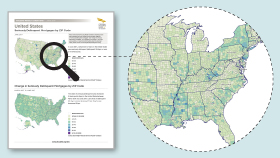Housing and Consumer Spending Are Powering the Economy like Never Before
The U.S. economic expansion entered its ninth year in July and soon will become the third-longest growth period since World War II (Table 1). It will become the longest post-World War II recovery if it endures through the second quarter of 2020.
Despite its length, the current expansion has been weak, ranking ninth among the 10 post-WWII business cycles.1 Only the previous cycle, ending in the second quarter of 2009, was weaker. That cycle was dominated by the housing boom and bust and culminated in the Great Recession. As Table 1 shows, the average rate of economic growth beginning in 2002 has been far below that in all of the other business cycles listed.
Table 2 shows that the composition of economic growth also has changed in recent decades, generally shifting in favor of housing and consumer spending.2 Only during the brief 1958-61 cycle did residential investment—which includes both the construction of new housing units and the renovation of existing units—contribute proportionally more to the economy’s growth than it has during the current cycle. Perhaps surprisingly, homebuilding subtracted significantly from economic growth during the previous business cycle even though the period included the housing bubble. The crash in residential investment was so severe between the fourth quarter of 2005 and the second quarter of 2009 that it erased all of housing investment’s previous growth contributions.3
Personal consumption expenditures (i.e., consumer spending) also have been very important in recent cycles. Consumer spending has contributed 74.9 percent of overall economic growth during this cycle so far, a share exceeded in only two other cycles. Not surprisingly, strong residential investment and strong consumer spending tend to coincide when households are doing well.4
The combination of weak overall GDP growth and strong contributions by both residential investment and consumer spending mark the defining characteristic of the current business cycle: Household-related spending is driving the economy like never before. Fully five-sixths, or 83 percent, of total growth since the economy began to recover in 2009 has been fueled by household spending. Hence, the continuation of the current expansion may depend largely on the strength of U.S. households.
Table 1
Post-World War II Business Cycles

[ EXPAND IMAGE ]
SOURCES: Bureau of Economic Analysis and National Bureau of Economic Research.
* Current cycle has not yet ended. See endnotes.
Table 2
Composition of GDP Growth in Post-WWII Business Cycles

[ EXPAND IMAGE ]
SOURCES: Bureau of Economic Analysis and National Bureau of Economic Research.
* Current cycle has not yet ended. See endnotes.
Endnotes
- “Business cycle” is defined here as the period beginning in the first quarter after the end of a recession through the last quarter of the next recession, for what is known as a “trough-to-trough” dating convention. The current cycle began in the third quarter of 2009; since the cycle has not yet ended, the provisional “end date” used in this analysis is the most recent quarter ended (second quarter of 2017). [ back to text ]
- The other components of gross domestic product (GDP) are business investment, exports and imports of goods and services, and government consumption expenditures and gross investment. [ back to text ]
- Residential investment typically subtracts from growth during recessions, so its ultimate contribution to the current cycle likely will be less than the amount shown in Table 2 because the next recession will be included as part of the current cycle. [ back to text ]
- The correlation between average contributions to real GDP growth of residential investment and consumer spending across the 10 business cycles considered here is 0.68 (1.00=total correlation). Both types of spending respond to income growth and financing conditions. [ back to text ]
This article originally appeared in our Housing Market Perspectives publication.
Citation
William R. Emmons, ldquoHousing and Consumer Spending Are Powering the Economy like Never Before,rdquo St. Louis Fed On the Economy, Sept. 6, 2017.
This blog offers commentary, analysis and data from our economists and experts. Views expressed are not necessarily those of the St. Louis Fed or Federal Reserve System.
Email Us
All other blog-related questions



